Feeding the Cats the HF Way
By: Rob Assise, Homewood-Flossmoor High School
When I started writing this in the spring of 2018, I went on what I thought would be a brief tangent about my evolution as a sprint coach. The result was the 3500+ word “Evolution to Essentialism.” Now in in the fall, I can get back to my original intent of describing how we structure our max velocity and acceleration days for the Homewood-Flossmoor Boys’ Track and Field Team. Before getting into the nuts and bolts of the programming, some initial criteria must be laid out:
◊ We use this structure primarily for the indoor portion of our season. We have a consistent indoor space which is 72 degrees and dry from January through mid-March. This makes it easy to design consistent daily programming amongst our sprinters, jumpers and hurdlers. When outdoor season hits, the weather tends to make it more complicated in getting all groups on the same page. While improving acceleration and maximum velocity is still a priority for all of our athletes, we also find it appropriate to be more specific in our programming for those who do more than just sprint. Sound planning involves going from general to specific as the year progresses.
◊ Our indoor facility is one of the best in the nation. That being said, everything addressed here except throwing implements can be done in a hallway.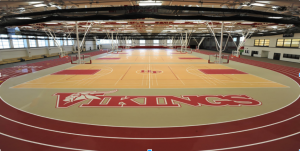
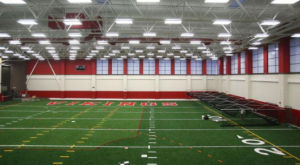
Our indoor facility includes a 6-lane 200 m track and a 40 yd x 55 yd turf room. Unfortunately, we are not allowed to run in spikes on our indoor track (spikes without spikes in them are okay). I do feel this has a negative impact on our training (and competition performances). Although the differences in sprint performance may be small, when you are training the nervous system via sprinting, thousandths matter!
◊ The structure is the best current solution we have developed for our program. We have between 50 and 60 athletes who fall in the sprinter, jumper, and hurdler category and three coaches to supervise. The athlete number can increase if our mid-distance/distance and/or throwing crew(s) join the party.
◊ We utilize a Freelap Timing System and have 18 functional chips.
◊ All of our athletes go through RPR, ankle rocker work, and our progressive speed development prior to the workout. The speed development is tailored to the workout (acceleration or max velocity). 25 minutes to get through this preparatory period.
Grouping
We have three stations our athletes rotate through (sprinting, jumping, and technique). They spend 16 minutes at each station. Transition time is three minutes. We are able to get through the workout in under an hour.
We seperate athletes into three groups (15 – 20 athletes each) based on their ability AND training age. We have found the division by ability enhances the competition within the group in the sprint station versus one large group (Tony Hollerś gauntlet excluded). Yes, they are ultimately competing against themselves via time, but the smaller groups make it easier to keep tabs on others who have similar times. I loosely equate this to the concept of zone of proximal development. An athlete who runs a 1.15 second 10 m fly could feel defeated if he was in a group of athletes under 1.05 and shut down. However if he is a group with athletes between 1.08 and 1.16, he will feel that reaching the top of his group is attainable. Not taking athlete mindset into account when designing training is like a chemist mixing substances together without considering how they will interact. The workout may look great on paper, but when put into a specific setting, things can blow up.
The division via training age allows us to prescribe an appropriate stimulus to each group. As much as we try to avoid it, large group training targets the mean. By dividing our athletes into three groups, we are able to target three means. Since the groups are smaller, each coach can make unique tweaks for an athlete, or a cluster of athletes, within each group. The goal is to get as close to individualization as possible. Further explanation of this will follow within each section’s explanation.
Sprint Station
This station is, without question, the most important. If for some reason we are unable to work through all three stations due to time constraints, we find a way to get everyone quality sprint reps. Below is a chart our head coach (Nate Beebe) created to make recording attempts easy for our managers. This frees him up to observe, film, and give feedback when needed. Each athlete is assigned a chip and their name is filled in the cell below the chip. The chart allows two people per chip, but we usually only have a handful of athletes who need to double up. You can never have enough chips! The less switching, the better. Assigning an athlete to a specific chip number eliminates confusion because chip number and time are shown when a rep is completed. It is especially important if more than one athlete is running at a time. Once the workout is complete, our managers (or a coach) will input the data into our master spreadsheet to be ranked and published.
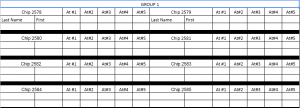
The advantage in the ability/training age grouping we use is different groups can do unique workouts. For example, our more seasoned athletes may be ready for fly 20’s, whereas our younger athletes still need fly 10 reps. The ease of moving the Freelap timing gates makes this transition seamless. In fact, it is so easy, it could even be done for different distances within the same group. This would be appropriate if you have a talented athlete with a low training age working with the talented athletes with a high training age.
During our maximum velocity days, we follow a one-minute protocol for every 10 m run. We will crowd that a bit during our acceleration sessions (30-45 seconds / 10 m run) to reap the rewards of the anabolic effects of lactate. In the 16 minutes, that could mean 4 – 5 x 30 m accelerations, 3 – 4 x 10 m flys, or 3 x 20 m flys. Our hurdlers tend to split this portion: 1/2 with barriers, 1/2 without.
Since this is the primary station, if we have an athlete who thrives as the rep count goes up, he can be held back as his group rotates to the next station. Simple auto-regulation (AREG) principles can be applied. Take the following example:
Athlete fly-10 progression: 1.03, 1.01, 1.00, 1.04
This athlete could continue run fly 10s until he hits 1.06 (6% slower than the best time of the day – AREG concepts taken from DB Hammer’s The Best Sports Training Book Ever! See the addendum for more information).
Jump Station
Being the jump coach, this tends to be my responsibility, and I love the challenge it provides! The reason why it is a challenge comes back to individualization.
Plyometrics should be individualized so as to provide the proper training stimulus for each athlete. – Boo Schexnayder
I could “roll out the ball” and have all three groups do the same activities. There are situations where this is appropriate, but most of the time I can provide a structure based on a needs assessment. Since our athletes are grouped by training age, it makes sense to have a novice, intermediate, and advanced workout. Our novice group spends most of their time completing in-place absorption and plyometric activities. Our intermediate and advanced groups will complete more intense variations of these activities in addition to other mobile plyometrics. Our ever-evolving plyometric inventory can be found here.
The break-down does not stop with three different workouts for each group. There are sprinters, jumpers, and hurdlers in each, and while similar in most aspects, the hurdles and jumps possess unique demands. In general, I design each group’s session with items all athletes in the group will complete, and then we divide into subgroups for event specific work. When things are rolling, it is organized chaos at its finest! Here is an example:
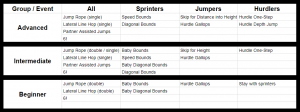
When designing the workouts for each group and subgroup, I resort to the matrix below to assist with attempting to cover as many bases as possible. I think the frontal and transverse planes are overlooked in the design of many track and field programs. Stability in the frontal plane leads to better performance in the sagittal plane. Watching athletes sprint around a curve, complete a high jump, or bring their trail leg through while hurdling makes it easy to see the validity of implementing movements in the transverse plane. Furthermore, even linear sprinting is a triplanar movement. I am aware that the transverse plane was not addressed in the chart above. It would have been taken care of earlier in the week, or planned to happen later in the week depending on when this particular session was held.

If you are looking for ideas for multi-planar activities, future TFC-8 presenter Jamie Smith of the U of Strength is a great follow on Twitter and Instagram. That being said, before you implement an exercise, please ask yourself how in fits into your programming goals. Just because it looks cool on social media does not mean it fits your situation. Novelty can be a great training tool if it fits your context.
Novelty can be a great training tool if it fits your context.
I usually incorporate a wide variety of exercises done in low volume because it builds resiliency (and helps keep scatterbrained teenage boys engaged). As we progress through the season, the number of exercises typically decreases, the quantity increases, and more attention is spent on items that are specific to an athleteś specialty.
We tend to run this structure twice per week. In the sprint station one session is acceleration focused, the second emphasizes maximum velocity. The plyometrics we complete will be aligned to the sprint workout of the day. This means hip dominant jumps (high degree of hip flexion) for acceleration and ankle dominant jumps (small degree of hip flexion) for maximum velocity. In addition, on maximum velocity days, I like to include something where the athlete mimics the progression from acceleration to maximum velocity. I call the drill below 6! (6 factorial) because the hurdles begin at a spacing of 6 feet apart, and progress down to 1 foot apart. The contact times and resultant vectors mimic an acceleration to top speed.
Technique Station
I will not spend too much time describing the technique station. Like the the jumping station, each group and subgroup can be assigned different tasks. I feel one of the biggest drivers of athlete improvement is intent. Learning occurs when intent is high, so it is our responsibility as coaches to have tweaks to maximize intent. For example, a senior athlete may be bored doing an acceleration wall drill for the 10,000th time. To improve his intent, you can challenge his stability by having him support himself with a medicine ball against the wall.
The chart below displays drills we use specific to maximum velocity and acceleration sessions. Like the jumping station, if it is a maximum velocity focus, we will try to incorporate an activity which implements the transition from acceleration to maximum velocity.
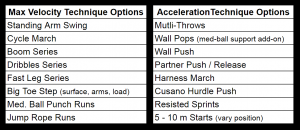
One drill not shown in this chart are mini-hurdle runs (wickets). Having used them for over 10 years, I am still amazed at how much a series of 6 inch hurdles can clean up an athleteś technique. We do our best to give all of our athletes a specific variation (arm action, surface, load, hurdle distance) which assist in correcting their technical issues. These would be done on a maximum velocity day, and I recommend no more than a few repetitions! This serves as protection to be able to perform their best if they are at this station prior to sprinting.
Considerations
We have tinkered with the order in which our three groups progress through the stations. We decide the order for our advanced group and then place the intermediate and novice. We have had mixed results. Items to consider regarding order:
◊ EVERYTHING revolves around the sprint station!
◊ The window to train maximum effort/capability is small. Determine when the window exists for your athletes and place them in the sprint station accordingly.
◊ One item which can help with this is classifying your athletes as ¨elastic¨ or ¨powerful.¨ In my experience, elastic athletes take more time to get their nervous system firing on all cylinders, and may benefit from completing the jumping and/or technique station before the sprint station. Powerful athletes are usually ready to roll right out of our speed development and are best served by sprinting first.
Including the preparation, this session should take under 90 minutes to complete. This leaves time for activity in the weightroom (if you find it be worthwhile). I would advise exercises with maximum effort and full recovery to stay in line with what was done on the track. Angles addressed in lifts can also be tailored to the sprint workout (i.e. 1/2 squat on acceleration days, 1/4 squat on maximum velocity days).
In the spirit of sharing, I encourage everyone to comment with a critique and/or variations you utilize based on your situation! We are all nothing more than a work in progress.
Addendum
*DB Hammer suggests beginning with a 6% drop-off on a 4 day scale (training the modality every 4th day). The percentage can be increased or decreased by 3%, with the scale increasing accordingly. In my opinion, if the objective is to enhance speed, 3 – 4 % is best, and top-end work can be addressed more frequently. That being said, seeking a different adaptation with a higher drop-off percentage may be appropriate for an individual.
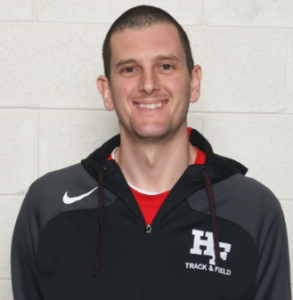 Rob Assise has 15 years of experience teaching mathematics and coaching track and field at Homewood-Flossmoor High School. He also has coached football and cross country. Rob has attended all seven Track-Football Consortiums and was a presenter at TFC-6 and TFC-7. Additional writing of his can be found at Simplifaster, Just Fly Sports, and ITCCCA. He can be reached via e-mail at robertassise@gmail.com or Twitter @HFJumps.
Rob Assise has 15 years of experience teaching mathematics and coaching track and field at Homewood-Flossmoor High School. He also has coached football and cross country. Rob has attended all seven Track-Football Consortiums and was a presenter at TFC-6 and TFC-7. Additional writing of his can be found at Simplifaster, Just Fly Sports, and ITCCCA. He can be reached via e-mail at robertassise@gmail.com or Twitter @HFJumps.

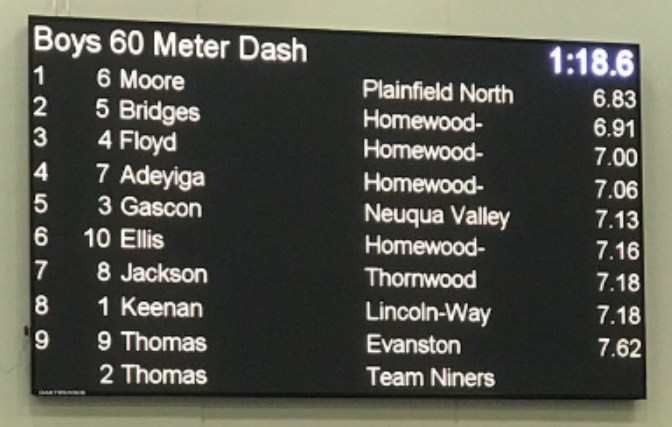
Great Information!! I’m ready for track now.
Outstanding analysis! This was extremely helpful. Thank you!
We do something similar at Lake Forest. An issue we run into each year is who will run the “jump” group. All my event coaches want to be at the technique station, and understandably so. The pole vault coach wants to work with the vaulters, LJ/TJ coach wants to work with his athletes, HJ coach wants to work with his athletes. My hurdlers get excluded often because I’m usually working the jump group AND making sure the Freelap is working (we have an injured kid write down the times).
Any suggestions? We normally have a team meeting that lasts around 5 minutes. Belly breathing takes 5 minutes. Warm-up takes around 15 minutes. Then we need to set up the rolling runway, which takes around 5-10 minutes. Have to put another 5-10 minutes at the end of practice to put the runways away. We only have two hours of gym space, so that only leaves us like 5-15 extra minutes of practice time. It’s hard to cram everything in.
We tend to do event specific technique on the day following one of these sessions. The technique which is addressed within the tech station is what unifies all the subgroups – running (sprinting).
Per groups…
What I’ve done in the past is, let’s say Monday is Fly’s and Tuesday is 150’s. I will take the 10m fly times from Monday and assign groups of four based on their times. Then each group of four races each other in the 150’s (outdoor track), stagger start and use the iPhone SprintTimer app. Everyone wants to be the next group up and everyone wants to win their group. Creates good competition. (Plus the F.A.T. looking picture they dig)
Love it! Maximize intent!